
High-altitude military parachuting, or military free fall (MFF), is a method of delivering military personnel, military equipment, and other military supplies from a transport aircraft at a high altitude via free-fall parachute insertion. Two techniques are used: HALO and HAHO.

Fort Moore is a United States Army post near Columbus, Georgia, adjacent to the Alabama–Georgia border. Fort Moore supports more than 120,000 active-duty military, family members, reserve component soldiers, retirees and civilian employees on a daily basis. As a power projection platform, the post can deploy combat-ready forces by air, rail, and highway for their designated mission. Fort Moore is the home of the United States Army Maneuver Center of Excellence, the United States Army Armor School, United States Army Infantry School, the Western Hemisphere Institute for Security Cooperation, elements of the 75th Ranger Regiment, the 1st Security Force Assistance Brigade, and other tenant units.
Fort Campbell is a United States Army installation located astride the Kentucky–Tennessee border between Hopkinsville, Kentucky and Clarksville, Tennessee. Fort Campbell is home to the 101st Airborne Division and the 160th Special Operations Aviation Regiment. The fort is named in honor of Union Army Brigadier General William Bowen Campbell, the last Whig Governor of Tennessee.

The Air Assault Badge is awarded by the U.S. Army for successful completion of the Air Assault School. The course includes three phases of instruction involving U.S. Army rotary wing aircraft: combat air assault operations; rigging and slingloading operations; and rappelling from a helicopter.

A parachutist badge is a military badge awarded by the armed forces of many states to soldiers who have received parachute training and completed the required number of jumps. It is difficult to assess which country was the first to introduce such an award.

The Military Freefall Parachutist Badge is a military badge of the United States Army and United States Air Force awarded to qualified U.S. Army and U.S. Air Force personnel as high-altitude military parachute specialists.

The Parachutist Badge, also commonly referred to as "Jump Wings" is a military badge of the United States Armed Forces. The United States Space Force and United States Coast Guard are the only branches that do not award the Parachutist Badge, but their members are authorized to receive the Parachutist Badges of other services in accordance with their prescribed requirements. The DoD military services are all awarded the same Military Parachutist Badge. The U.S. Army and U.S. Air Force issue the same Senior and Master Parachutist Badges while the U.S. Navy and U.S. Marine Corps issue the Navy and Marine Corps Parachutist Badge to advanced parachutists. The majority of the services earn their Military Parachutist Badge through the U.S. Army Airborne School.

The 507th Parachute Infantry Regiment, now the 507th Infantry Regiment, is an airborne infantry regiment of the United States Army. The regiment was initially assigned to the 82nd Airborne Division in World War II before transferring to the 17th Airborne Division. Now 1st Battalion, 507th Infantry Regiment is part of the United States Army Infantry School, subordinate to its Airborne and Ranger Training Brigade, responsible for the Army's Basic Airborne School, Jumpmaster School, Pathfinder School, and the "Silver Wings" Command Exhibition Parachute Team.

The United States Army Airborne School—widely known as Jump School—conducts the basic paratrooper training for the United States Armed Forces. It is operated by the 1st Battalion (Airborne), 507th Infantry, United States Army Infantry School, Fort Moore, Georgia. The Airborne School conducts the Basic Airborne Course, which is open to troops from all branches of the United States Department of Defense, Reserve Officer Training Corps, and allied military personnel.

A static line is a fixed cord attached to a large, stable object. It is used to open parachutes automatically for paratroopers and novice parachutists.
A parachute rigger is a person who is trained or licensed to pack, maintain or repair parachutes. A rigger is required to understand fabrics, hardware, webbing, regulations, sewing, packing, and other aspects related to the building, packing, repair, and maintenance of parachutes.
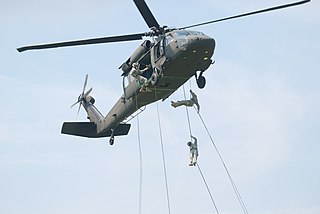
The United States Army Air Assault School, is a Army Forces Command Table of Distribution and Allowances unit located at Fort Campbell, Kentucky. Its primary task is training leaders and soldiers assigned to the 101st Airborne Division (AASLT), other United States Army units, and United States Armed Forces service members. The school is named for Command Sergeant Major Walter James Sabalauski.
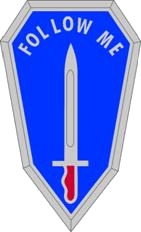
The United States Army Infantry School is a school located at Fort Moore, Georgia that is dedicated to training infantrymen for service in the United States Army.
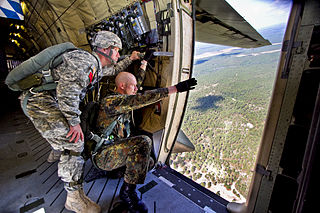
Jumpmasters are the expert paratroopers in an airborne unit who train and teach the military techniques for jumping from airplanes. They are responsible for training soldiers who enter Army Airborne School into paratroopers and managing airborne jump operations in airborne units across all branches of services.
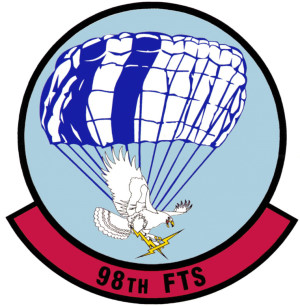
The 98th Flying Training Squadron is a United States Air Force unit assigned to the Air Education and Training Command 306th Flying Training Group. It is stationed at the United States Air Force Academy, Colorado, however the current UV-18 B Twin Otter aircraft are housed and maintained at nearby Peterson Air Force Base, Colorado.

A Special Amphibious Reconnaissance Corpsman (SARC) is a United States Navy hospital corpsman who provides MARSOC and other USSOCOM units advanced trauma management associated with combatant diving and parachute entry. Traditionally, they are attached to the Marine Corps Force Reconnaissance companies to help support the Command Element of the Marine Air-Ground Task Force in special reconnaissance missions.

The United States Army Maneuver Center of Excellence Command Exhibition Parachute Team, commonly known as the Silver Wings, is the official demonstration parachute team of Fort Benning, Georgia, United States Army. It is made up of US Army Paratroopers who have demonstrated excellence in parachuting skills, drawn primarily from the 1st Battalion of the 507th Parachute Infantry Regiment, Fort Benning.
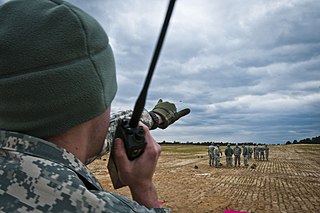
The United States Army Pathfinder Course trains military personnel in the U.S. Army and its sister services to set up parachute drop zones and helicopter landing zones for airborne and air assault missions.

Aircrew survival equipmentmen are survival equipment specialists and certified parachute riggers who oversee valuable life saving equipment, parachutes, and other special gear used by U.S. Naval and Marine Corps special operations forces, Naval Air Department, and the United States Navy Parachute Team known as the "Leap Frogs". They perform a wide range of duties, which include inspecting, maintaining, and repairing parachutes, search and rescue equipment, along with survival kits, medical kits, flight clothing, protective wear, night vision equipment, aircrew oxygen systems, liquid oxygen converters, anti-exposure suits, and g-suits. PRs operate and maintain carbon dioxide transfer and recharge equipment, operate and repair sewing machines as well as train aircrew and other personnel in parachute rigging and the use of safety and survival equipment.
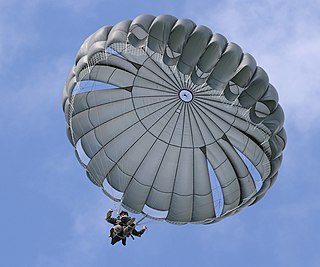
The MC-6 Parachute is a Maneuverable Canopy(MC) static line-deployed personnel parachute of the United States Armed Forces. Developed by United States Army Special Forces, the parachute has been used by American Special Operations Forces (SOF) beginning in 2006 and Australian SOF starting in 2011.


























